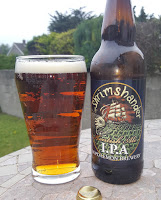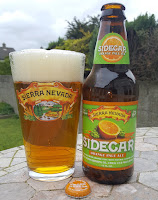Though they're by no means shy about local beers, opening night saw taps 1 through 6 dedicated to Lervig in Norway. That's why my first UnderDog beer was a glass of Supersonic, and I'd say that's true for a lot of people, the beer very much living up to its name for the few hours it lasted. It's a double IPA built on a classic American chassis, heavy with syrupy malt and tasting all of its 9% ABV. Offsetting this is the hops, not with a balancing bitterness but with a huge juicy tropical flavour, exactly like those lurid orange mixed-fruit breakfast juices. Like a lot of hyped-up specials that circulate these days it's not very complex, but it's quite enjoyable for the single glass that I guess the brewery is expecting people to drink.
 A proper novelty beer to follow: Passion Tang. It's fun and a little bit silly, even if the ABV is a fairly serious 7%. There's a spicy perfume quality to the added passionfruit, which gives it an extra level of depth that other passionfruit-infused sour beers rarely match (sorry Castaway!). While far from sweet it's not really sour either, plotting its own course between them. I liked it, though again it's a one-go beer before moving on.
A proper novelty beer to follow: Passion Tang. It's fun and a little bit silly, even if the ABV is a fairly serious 7%. There's a spicy perfume quality to the added passionfruit, which gives it an extra level of depth that other passionfruit-infused sour beers rarely match (sorry Castaway!). While far from sweet it's not really sour either, plotting its own course between them. I liked it, though again it's a one-go beer before moving on.Last of the set here was 3 Bean Stout, a 13% ABV beast of a thing, employing cocoa, vanilla and tonka beans. It's hellishly thick, almost like drinking treacle. The flavour offers a blend of old-world spices -- cinnamon and ginger -- which, coupled with the sweetness and density, give a Christmas cake or mince pie effect. Not exactly suited to a warm summer's evening, but no matter. Once more, though, I found myself expecting more from the flavour than it delivered. If they dialled back on the novel ingredients and let the stout speak for itself I think they'd have a better and more interesting beer.
There's plenty more from UnderDog's taps on the way, but while I'm on a Lervig kick, a couple more from them which I had at home.
 Props to the brewery for putting its hype magnet IPA Tasty Juice in a 500ml can instead of the 440s more common to brewers wanting their beer to look less common. Claims of dankness and tropicality plastered over the can -- plain silver with an abstract decorated label -- leave the buyer in no doubt about what to expect. Yes, it's murky: a solid pale orange with a desultory off-white head. The aroma isn't too powerful but it's definitely dank. Citra is the billed dry hop and the smell certainly backs that up. The texture is pretty smooth though it doesn't have the full-on fluffiness that true-to-style New England IPAs flaunt. And to my mind that's a good thing because, here it is kids: juice isn't fluffy. Those big-bodied New England style hop bursters that purport to be juicy are not, because of that candyfloss texture. This one has dialled that back a little and extra juiciness is the reward for it. I get passionfruit in particular, mango around the edges and finishing bitterer with guava or even (whisper it) grapefruit. The bittering doesn't disturb the softness and merely serves to make the beer extra mouth-watering. This is a barnstormer of a beer: big-flavoured, showing enough of the merits of the New England affectation we're currently living through while also a classic Citra-driven IPA to its core.
Props to the brewery for putting its hype magnet IPA Tasty Juice in a 500ml can instead of the 440s more common to brewers wanting their beer to look less common. Claims of dankness and tropicality plastered over the can -- plain silver with an abstract decorated label -- leave the buyer in no doubt about what to expect. Yes, it's murky: a solid pale orange with a desultory off-white head. The aroma isn't too powerful but it's definitely dank. Citra is the billed dry hop and the smell certainly backs that up. The texture is pretty smooth though it doesn't have the full-on fluffiness that true-to-style New England IPAs flaunt. And to my mind that's a good thing because, here it is kids: juice isn't fluffy. Those big-bodied New England style hop bursters that purport to be juicy are not, because of that candyfloss texture. This one has dialled that back a little and extra juiciness is the reward for it. I get passionfruit in particular, mango around the edges and finishing bitterer with guava or even (whisper it) grapefruit. The bittering doesn't disturb the softness and merely serves to make the beer extra mouth-watering. This is a barnstormer of a beer: big-flavoured, showing enough of the merits of the New England affectation we're currently living through while also a classic Citra-driven IPA to its core. Appearing in shops around the same time was Perler for Svin, this one badged as a "juicy IPA" in the description though it comes in a 33cl bottle -- how retro! It looks pretty unpleasant in there, murky globules slopping around behind the brown glass. Pouring it wasn't any improvement, with huge visible lumps hanging in the headless orangey liquid. The aroma is fairly pleasant, however: not banging out hops but certainly presenting a combination of tropicality and garlic-to-caraway savouriness. The flavour leans to the savoury side too, after an initial flash of pineapple and guava. And I'm not at all sure that the hops are the dominant partner here. Yes there's a spring onion green acidity but I also get a strong grittiness which I'd be reasonably certain is down to yeast: it's a taste I associate with badly-poured bottle-conditioned English ales, or the tail end of casks.
Appearing in shops around the same time was Perler for Svin, this one badged as a "juicy IPA" in the description though it comes in a 33cl bottle -- how retro! It looks pretty unpleasant in there, murky globules slopping around behind the brown glass. Pouring it wasn't any improvement, with huge visible lumps hanging in the headless orangey liquid. The aroma is fairly pleasant, however: not banging out hops but certainly presenting a combination of tropicality and garlic-to-caraway savouriness. The flavour leans to the savoury side too, after an initial flash of pineapple and guava. And I'm not at all sure that the hops are the dominant partner here. Yes there's a spring onion green acidity but I also get a strong grittiness which I'd be reasonably certain is down to yeast: it's a taste I associate with badly-poured bottle-conditioned English ales, or the tail end of casks.I just wasn't as impressed by this as I was by the Tasty Juice, and it could well be that freshness is the issue. "Drink Soon" implored the Perler label, though there was still a full six months left on the best-before. I dread to think what would happen to the aroma and flavour before it officially expired.
They're an extreme bunch, this set from Lervig. The flavours are big and bold, but I detect a seam of cartoonish two-dimensionality running through it all. Can a brewery really build a reputation on artfully presented one-sip-wonders like these?












































